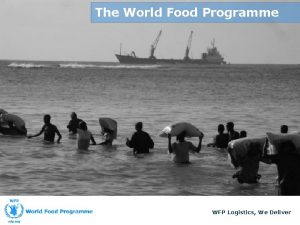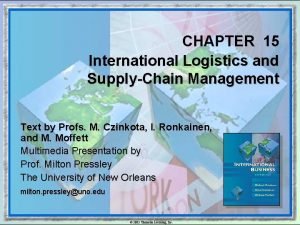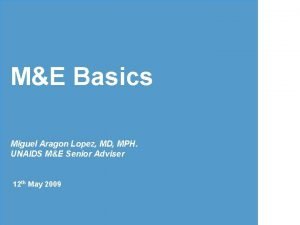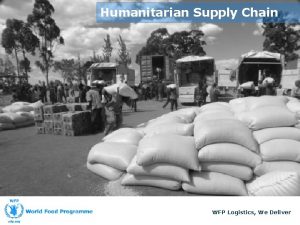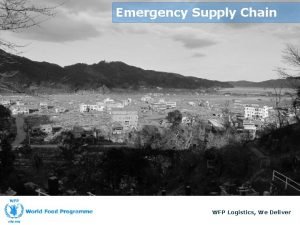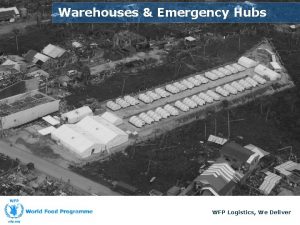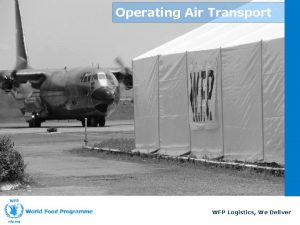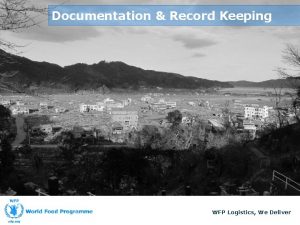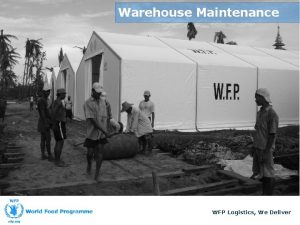Supply Chain Partnerships WFP Logistics We Deliver Lesson














- Slides: 14

Supply Chain Partnerships WFP Logistics, We Deliver

Lesson Plan: Supply Chain Partnerships LEARNING OBJECTIVES: By the end of the session, participants will be able to: Describe the difference between commercial and humanitarian supply chains Describe when to outsource logistics services Describe of the role and capabilities of partners Structure Timing Introduction 5 minutes Activities Explain lesson objectives Commercial Supply Chain Management 20 minutes Video: Introduce supply chain management from commercial perspective of managing partnerships. Discuss how this compares to humanitarian supply chains Philippines Example 10 minutes Outline the structure of the Philippines Government food response to Typhoon Haiyan. Identify partners involved; the benefits of the setup and its constraints. Private Sector and Outsourcing 20 minutes What types of logistics services can be outsourced to the private sector; benefits and risks of doing so and what to consider when doing so. Role and capabilities of militaries and local actors 10 minutes Outline the role and capabilities of national militaries play in emergencies. Enlisting local NGO’s and community groups to augment operational capacity Exercise: Case Studies 15 minutes Working with the military, district administration and community groups Lesson End/Plenary 5 minutes Total Lesson Length 90 minutes EVALUATION / RECAP QUESTIONS: The facilitator should ask the questions below, or similar questions to the class to recap the lesson to ensure participants have understood the lesson content. Under what conditions would you expect to work with militaries? Which circumstances would you expect to work with local community groups? When would you want to outsource the warehousing function to a private provider?

Lesson Objectives By the end of this lesson, you will be able to: 1 Describe the difference between commercial and humanitarian supply chains 2 Describe when to outsource logistics services 3 Describe of the role and capabilities of key partners

Example: Philippines Emergency Supply Chain National Food Authority Repacking Centre Commercial suppliers MSWD Town Halls Barangay Captains

Outsourcing to Private Sector Partners Relief Goods Distribution Your agency’s Warehouse Your agency’s transport Relief Goods Distribution Privately run Warehouse Privately run transport

Private Sector as Humanitarian Actors Corporate Social Responsibility Example: Logistics Emergency Team (LET) Examples from your country?

Domestic Partners Consider each of the following groups. What is the benefit of working with them? What are the challenges? National military forces Municipal and district government bodies Local community groups and NGO’s

Working with the Military Opportunities Logistics Capacity and Infrastructure Security and safety Access to beneficiaries Challenges Protecting Humanitarian Principles Coordination Competition for resources

Military Partners and Humanitarian Space What is meant by the term ‘Humanitarian Space’? Availability & Impartiality of Forces Decrease Mission of Military Humanitarian Tasks Direct Visibility of Task Decreases Indirect Infrastructure Support Peaceful Peace Support or Peace Operation Peacekeeping Maybe Yes Peace Enforcement No Maybe Yes Combat No No Maybe © UN OCHA

Military Culture and Implications on Partnerships General Organizational Culture Implications on Meeting Management Coordination and Information Sharing Operational impact of the Mission Deployment and Support Requirements

Exercise: Working with the Military Case Study 1 The Mewong Armed Forces are transporting your agency’s relief goods to the town of Tonle, but you have just been informed you need to divert some items instead to the town of Nakhon. You ask the head of the marines if he can accommodate your request, but he says Nakhon falls under the command of a different unit, he has no authority to travel there. What do you do?

Exercise: Working with District Administrators Case Study 2 You have agreed a distribution plan to be implemented by the local district administrations. The plan requires one of the administrations, Rach Chuen, to have at least 6 trucks for transport of cargo from the town hall to the distribution sites on each day of the distributions. On the first day of distributions you discover the office only has access to 2 trucks. What do you do?

Recap Lesson Questions: 1 What are some of the Coordination Challenges between Humanitarian Actors? 2 Who are the Main Actors and their roles in the Logistics Cluster?

Questions WFP Logistics, We Deliver
 Wfp logistics
Wfp logistics Wfp logistics
Wfp logistics Value chain and supply chain difference
Value chain and supply chain difference E-crm and scm
E-crm and scm International logistics and supply chain outsourcing
International logistics and supply chain outsourcing Ford cmms
Ford cmms Global logistics and supply chain management
Global logistics and supply chain management Vision statement for supply chain management
Vision statement for supply chain management Logistics and supply chain management
Logistics and supply chain management Wfp cfm
Wfp cfm Miguel aragon
Miguel aragon 4ps of leadership
4ps of leadership Wfp vendor registration
Wfp vendor registration Super cereal plus
Super cereal plus Matching supply and demand in supply chain
Matching supply and demand in supply chain
